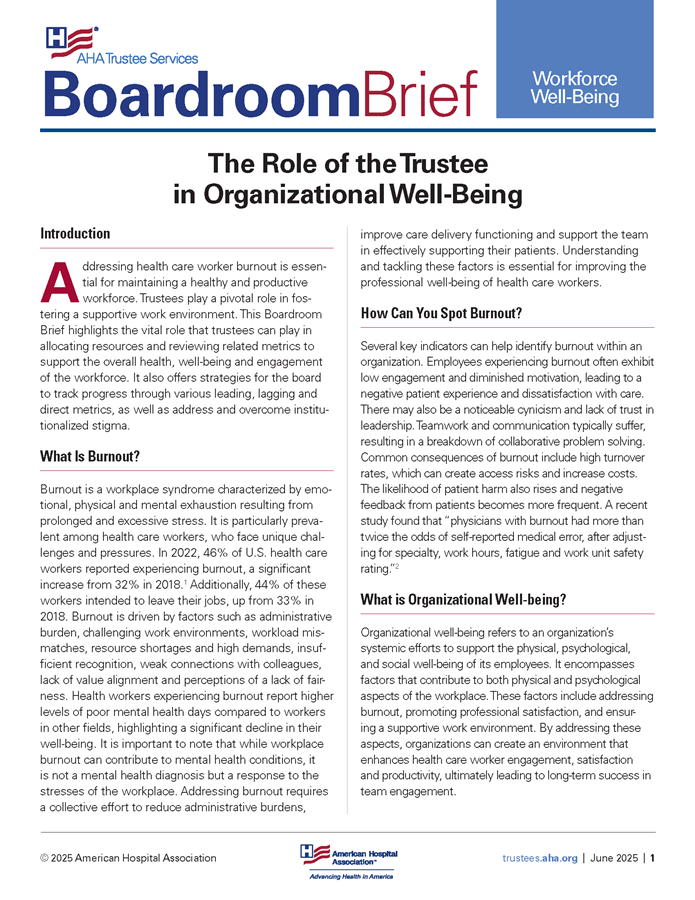Boardroom Brief: The Role of the Trustee in Organizational Well-Being
Workforce Well-Being
Introduction
Addressing health care worker burnout is essential for maintaining a healthy and productive workforce. Trustees play a pivotal role in fostering a supportive work environment. This Boardroom Brief highlights the vital role that trustees can play in allocating resources and reviewing related metrics to support the overall health, well-being and engagement of the workforce. It also offers strategies for the board to track progress through various leading, lagging and direct metrics, as well as address and overcome institutionalized stigma.
What Is Burnout?
Burnout is a workplace syndrome characterized by emotional, physical and mental exhaustion resulting from prolonged and excessive stress. It is particularly prevalent among health care workers, who face unique challenges and pressures. In 2022, 46% of U.S. health care workers reported experiencing burnout, a significant increase from 32% in 2018.1 Additionally, 44% of these workers intended to leave their jobs, up from 33% in 2018. Burnout is driven by factors such as administrative burden, challenging work environments, workload mismatches, resource shortages and high demands, insufficient recognition, weak connections with colleagues, lack of value alignment and perceptions of a lack of fairness. Health workers experiencing burnout report higher levels of poor mental health days compared to workers in other fields, highlighting a significant decline in their well-being. It is important to note that while workplace burnout can contribute to mental health conditions, it is not a mental health diagnosis but a response to the stresses of the workplace. Addressing burnout requires a collective effort to reduce administrative burdens, improve care delivery functioning and support the team in effectively supporting their patients. Understanding and tackling these factors is essential for improving the professional well-being of health care workers.
How Can You Spot Burnout?
Several key indicators can help identify burnout within an organization. Employees experiencing burnout often exhibit low engagement and diminished motivation, leading to a negative patient experience and dissatisfaction with care. There may also be a noticeable cynicism and lack of trust in leadership. Teamwork and communication typically suffer, resulting in a breakdown of collaborative problem solving. Common consequences of burnout include high turnover rates, which can create access risks and increase costs. The likelihood of patient harm also rises and negative feedback from patients becomes more frequent. A recent study found that “physicians with burnout had more than twice the odds of self-reported medical error, after adjusting for specialty, work hours, fatigue and work unit safety rating.”2
What Is Organizational Well-being?
Organizational well-being refers to an organization’s systemic efforts to support the physical, psychological, and social well-being of its employees. It encompasses factors that contribute to both physical and psychological aspects of the workplace. These factors include addressing burnout, promoting professional satisfaction, and ensuring a supportive work environment. By addressing these aspects, organizations can create an environment that enhances health care worker engagement, satisfaction and productivity, ultimately leading to long-term success in team engagement.
The Role of Trustees in Organizational Well-being
Trustees can play a crucial role in promoting employee well-being by ensuring that organizational commitment is strategic, proactive and integrated. For example, at a foundational level, trustees should routinely review direct measures of well-being alongside workforce metrics on turnover, retention and engagement. As efforts progress, regular assessment of leading, lagging and direct measures of well-being should become part of a cohesive workforce strategy review. As progress continues, additional education on workforce well-being should be provided to board members along with regular reports on key performance indicators (KPIs) related to well-being. For resources please check the links below. This integrated approach, overseen by a well-being leader and supported by both executive leadership and the workforce, ensures that well-being efforts are comprehensive and aligned.
Trustee Discussion Questions
- What opportunities exist for your organization to advance professional well-being efforts?
- What data is available to understand and track professional well-being at your organization?
- When and where do professional well-being conversations happen at your organization?
- How can we help support management in prioritizing this work?
Conclusion
Addressing burnout and promoting well-being are essential for a healthy, productive workforce. Trustees play a key role by monitoring metrics, prioritizing resources, understanding leadership supports and reducing stigma. Focusing on leading, lagging and direct measures provides insights for informed decisions. Strategic initiatives and policy changes can mitigate burnout and improve mental health, ensuring organizations support their workforce in delivering high-quality care. These steps are just the beginning. As you move forward, please utilize the resources below to continue expanding and enhancing programs within your organization.
How Can Trustees Engage with This Topic?
Trustees can engage in well-being initiatives by closely monitoring metrics that reflect employee well-being and understanding the leadership supports in place.
- Understand Data Metrics to Track Progress. Use leading indicators (e.g., work time outside regular hours, cognitive load, shift variance) to identify potential issues early, and lagging indicators (e.g., absenteeism, turnover, Net promoter score, unscheduled premium compensation) to understand current work climate. Direct metrics related to engagement and well-being provide real-time insights into the workforce’s current state.
- Understand Leadership Supports in Place. Evaluate how well-being programs are being integrated across the organization. Initially, departments may lead programs independently. As efforts progress, look for a coordinated approach with a well-being committee and executive lead.
- Understand Communication Channels. Ensure that communication is bi-directional and integrated across the organization to ensure programs being implemented both reflect local challenges and are known and accessed by the full team.
- Reduce Institutionalized Stigma. Ensure that institutional policies, procedures and forms support the mental health of the workforce. Advocate for the removal of invasive mental health questions from licensing, credentialing and insurance applications. The Resources section of this Boardroom Brief provides an example on reducing stigmatizing language.
By focusing on these actions, trustees can enhance the professional well-being and mental health of health care workers, ultimately improving organizational health and performance.
AHA Resources
- Building a Systemic Well-being Program: A 5-Step Blueprint: The AHA’s Physician Alliance and the Collaborative for Healing and Renewal in Medicine have released a five-step blueprint to help health care leaders build a systemic well-being program to prevent health care worker burnout. The resource shares case examples, lessons learned and resources to help guide and enrich organizational well-being efforts.
- Science-Based Strategies to Promote Clinician Well-being and Safety: Human Factors and Ergonomics (HFE) draws from multiple sciences to understand and improve interactions between people and their work environment. Applying the science behind HFE empowers leaders to strategically budget the highly trained cognitive resources of their institution and reduce the occupational stress on clinicians and others.
- Revisiting Clinician Credentialing to Support Well-being: The American Hospital Association (AHA) advocates for eliminating barriers to mental health care for health care workers. We encourage hospitals to revise credentialing processes to remove intrusive questions, thereby fostering a supportive environment that promotes mental health.
- Suicide Prevention in the Health Care Workforce: This AHA guide identifies three drivers of suicide: stigma, limited access to behavioral health resources and treatment and job-related stressors. This guide offers a curated list of 12 evidence-informed interventions that hospitals and health systems can implement to reduce the risk of suicide among health care workers.
- People Matter Words Matter: The AHA, together with behavioral health and language experts from member hospitals and partner organizations, has created a continuing series of “People Matter, Words Matter” posters to help health care workers and others adopt person-first, respectful language that aims to reduce stigma surrounding issues such as suicide, substance use disorder, pediatric and adolescent mental health and others. The posters are free and can be printed and shared with team members.
 Dr. Lorna Breen Heroes’ Foundation Resources
Dr. Lorna Breen Heroes’ Foundation Resources
- Impact Wellbeing™ Guide: Developed in collaboration with the CDC NIOSH, this guide offers a step-by-step process for hospitals to start making organizational-level changes that will impact and improve the professional well-being of their employees.
- Caring for Caregivers: This program assists healthcare organizations in improving workplace policies and practices that reduce burnout, normalize help-seeking, and strengthen professional well-being — accelerating impact to improve health workers’ well-being and mental health.
- Wellbeing First Champion Challenge: The Wellbeing First Champion Challenge program supports hospitals and health systems in auditing and changing (as needed) applications, forms and addenda to be free of intrusive mental health questions and stigmatizing language.
- ALL IN for Mental Health: This initiative provides six actions to improve access to mental health care for health workers — addressing unique stressors, eliminating stigma and creating a system that supports professional wellbeing and safe, compassionate patient care.

